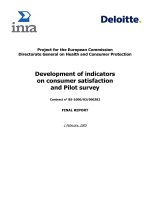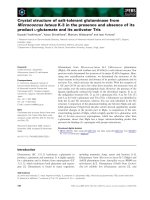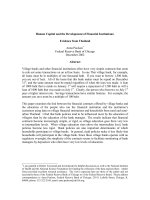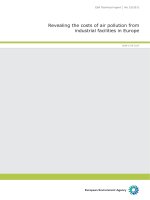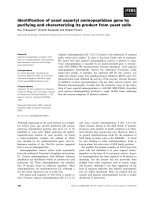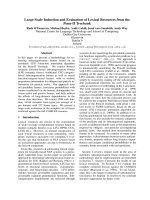Development of Chese Product From Coconut Milk-Alfred Kabutey Ocansey pot
Bạn đang xem bản rút gọn của tài liệu. Xem và tải ngay bản đầy đủ của tài liệu tại đây (1.21 MB, 147 trang )
KWAME NKRUMAH
UNIVERSITY OF SCIENCE AND TECHNOLOGY
KUMASI, GHANA
DEPARTMENT OF BIOCHEMISTRY AND BIOTECHNOLOGY
FACULTY OF BIOSCIENCES
COLLEGE
OF
SCIENCE
MSC FOOD SCIENCE AND
TECHNOLOGY
THESIS
Top
ic:
DEVELOPMENT OF CHEESE PRODUCT
FROM
COCONUT
MILK
By:
ALFRED
KABUTEY
OCANSEY
FEBRUARY 2010
i
KWAME NKRUMAH
UNIVERSITY OF SCIENCE AND TECHNOLOGY
KUMASI, GHANA
DEPARTMENT OF BIOCHEMISTRY AND BIOTECHNOLOGY
FACULTY OF BIOSCIENCES
COLLEGE OF SCIENCE
MSC FOOD SCIENCE AND TECHNOLOGY
Topic:
DEVELOPMENT OF CHEESE PRODUCT
FROM COCONUT MILK
A THESIS SUBMITTED TO THE BOARD OF POST GRADUATE STUDIES,
KWAME NKRUMAH UNIVERSITY OF SCIENCE AND TECHNOLOGY IN
PARTIAL FULFILLMENT OF THE REQUIREMENTS FOR THE AWARD OF THE
MASTER OF SCIENCE (MSC) DEGREE IN FOOD SCIENCE AND TECHNOLOGY.
By:
ALFRED KABUTEY OCANSEY
Supervisor:
Prof J.H. Oldham
ii
DECLARATION
I hereby declare that this work is the result of my own original research and that no part
of it has been published part or in whole for another certificate in this university or
anywhere else.
Cand
id
ate:
Name: …………………………………………………………………….
Signature: …………………………………………………………………….
Date: …………………………………………………………………….
Sup
ervisor:
Name: …………………………………………………………………….
Signature: …………………………………………………………………….
Date: …………………………………………………………………….
Certif
ied b
y:
Head of Department: …………………………………………………………….
Signature: ……………………………………………………………………
Date: ……………………………………………………………………
iii
ACKNOWLEDGEMENT
I acknowledge with contentment the fulfilled presence of God as wisdom, strength and
ability throughout the period and process of fulfilling this critical obligation to my
life‟s
work.
I acknowledge with gratitude the consistent and focused supervision of Prof. J. H.
Oldham that steered and refined the processes of this critical output to my
life‟s
work.
I acknowledge with affection the undying support and encouragement of a loving mum, a
brother and a partner who constitutes my family now and into forever.
Thank You!
iv
ABSTRACT
The project was aimed at the preparation of cheese products by partial substitution of
cow‟s milk with coconut milk and investigating the proximate quality, textural
characteristic, keeping quality and sensory attributes of the developed product. The yield
of cheese was 305.4 g, 151.8 g and 270.0 g per 1000 g respectively of 100% cow‟s milk
cheese product, 100% coconut milk product and a 50%:50% blend of both. Laboratory
analysis was carried out to ascertain the extent of variation in moisture, protein, fat and
ash content. Moisture, ash and fibre contents increased with increasing coconut milk
content while the opposite was recorded for protein content, which peaked at 17.26% for
100% cow‟s milk cheese. Salting samples in 10% NaCl solution retarded the rate of
change of all parameters. The keeping quality was determined to be three (3) days for all
product treatments (raw, boiling in water and boiling in 10% NaCl) which was extended
to seven (7) days by repeated boiling (on days 2 and 4) and to twenty (20) days by
repeated boiling on days 2, 4, 8, 12 and 16 in 10% NaCl. The flavour characteristic was
scored the highest in respect of sensory appeal while colour recorded the lowest average
scores. The strongest correlation was between taste and curd firmness (0.226), however at
P<0.05 level the correlation between curd firmness and colour was the most significant.
The 70% cow‟s milk: 30% coconut milk cheese product was the most preferred and
recommended for market exploration.
v
TABLE OF
CONTENTS
TITLE PAGE
DECLARATION
iii ACKNOWLEDGEMENT
iv
ABSTRACT v
TABLE OF CONTENTS vi
LIST OF FIGURES viii
LIST OF TABLES
viii CHAPTER 1
1
1.0 INTRODUCTION
1
1.1 OBJECTIVES 3
CHAPTER 2 4
2.0 LITERATURE REVIEW 4
2.1 COCONUT 4
2.1.1 COCONUT FAT 4
2.1.2 COCONUT MEAT 6
2.1.3 COCONUT MILK
7
2.2 MILK 8
2.2.1 DEFINITION OF MILK 8
2.2.2 SOURCES OF MILK 8
2.2.3. WORLD MILK PRODUCTION
8
2.2.4 MILK PRODUCTION IN GHANA
9
2.2.5 CONSTITUENTS OF MILK 10
2.2.6. PHYSICAL PROPERTIES OF MILK
18
2.2.7. NUTRITIONAL FUNCTIONS OF MILK 20
2.2.8. ALTERATION OF MILK THROUGH PROCESSING AND THE
EFFECT ON NUTRITIVE VALUE 21
2.2.9. KEEPING QUALITY OF MILK 24
2.3 CHEESE
26
2.3.1 DEFINITION OF CHEESE 26
2.3.2 CHEESE PRODUCING POTENTIAL OF MILK
26
2.3.3 COMPOSITION OF CHEESE
27
2.3.4 CLASSIFICATION OF CHEESE
27
2.3.5 CHEESE PRODUCTION AROUND THE WORLD
29
2.3.6 MANUFACTURE OF CHEESE, ROLE OF ENZYMES, PROTEINS AND
FAT 31
2.3.7 TRADITIONAL CHEESE PRODUCTION IN WEST AFRICA
37
2.3.8 CHANGES IN CHEESE DURING RIPENING
38
2.3.9 SPOILAGE OF CHEESE
40
2.3.10. OCCURANCE OF PATHOGENS IN CHEESE 41
2.3.11 STORAGE AND PRESERVATION OF CHEESE 41
2.4 UTILIZATION OF COCONUT MILK IN THE MANUFACTURE OF “SOFT
CHEESE” (COCONUT CHEESE)
43
2.4.1 FRESH SOFT CHEESE (CADTRI CHEESE) 43
vi
2.4.2 COCONUT MILK AND FILLED CHEESE MILK 44
2.4.3 USE OF COCONUT IN BLUE-TYPE CHEESE PRODUCTION 45
2.4.4 FORMULATIONS OF COCONUT AND SKIMMED MILK IN WHITE
SOFT CHEESE PRODUCTION 46
CHAPTER 3 48
3.0 MATERIALS AND METHODS 48
3.1 MATERIALS 48
3.2 METHODS 48
3.2.1 PREPARATION OF COCONUT MILK 48
3.2.2 PREPARATION OF CALOTROPIS PROCERA EXTRACT (Enzyme) 48
3.3 PROXIMATE ANALYSIS OF CHEESE PRODUCTS 49
3.3.1 MOISTURE CONTENT 49
3.3.2 CRUDE PROTEIN CONTENT 49
3.3.3 FAT CONTENT 50
3.3.4 CRUDE FIBRE DETERMINATION 51
3.3.5 ASH DETERMINATION 51
3.3.6 TITRABLE ACIDITY 52
3.3.7 CURD FIRMNESS 52
3.3.8 RANCIDITY (THIOBARBITURIC ACID COLORIMETRIC TEST) 52
3.4 DETERMINATION OF KEEPING QUALITY OF CHEESE PRODUCT
SAMPLES
53
3.4.1 SINGLE BOILING PROCESS 53
3.4.2 REPEATED (CONTINUOUS) BOILING PROCESS 53
3.5 SENSORY EVALUATION 53
3.4.1 PREPARATION OF SAMPLES FOR SENSORY EVALUATION 53
3.5 STATISTICAL ANALYSIS 54
CHAPTER FOUR 55
4.0 RESULTS AND DISCUSSION 55
4.1 YIELD OF CHEESE 55
4.2 PROXIMATE ANALYSIS AND TITRABLE ACIDITY OF CHEESE SAMPLES
56
4.3 KEEPING QUALITY OF CHEESE SAMPLES 58
4.3.1 SINGLE BOILING PROCESS 58
4.3.2 REPEAT (CONTINUOUS) BOILING PROCESS 66
4.4 SENSORY EVALUATION OF CHEESE SAMPLES 67
4.4.1 CORRELATION BETWEEN PARAMETERS OF DEVELOPED
SAMPLES 74
CHAPTER 5 75
5.0 CONCLUSION AND RECOMMENDATIONS 75
5.1 CONCLUSION 75
5.2 RECOMMENDATIONS 75
CHAPTER 6 76
6.0 REFERENCES 76
CHAPTER 7 86
7.0 APPENDICES 86
7.1. APPENDIX 1 - SENSORY EVALUATION FORM 86
vii
7.2 APPENDIX 2 - ANOVA OF DATA ON YIELD OF CHEESE SAMPLES 87
7.3 APPENDIX 3 - ANOVA OF DATA ON NUTRITIONAL COMPOSITION OF
CHEESE SAMPLES
87
7.4 APPENDIX 4 - PAIRED T-TEST ON DATA SENSORY ANALYSIS 88
7. 5 APPENDIX 5 - MEAN SCORES OF PANELLISTS ON SENSORY
PARAMETERS 121
7. 6 APPENDIX 6 - RAW SCORE OF SENSORY PANELLISTS 122
7. 7 APPENDIX 7 – FORMULAS FOR PROXIMATE CALCULATIONS 127
7.7.1 MOISTURE CONTENT 127
7.7.2 CRUDE PROTEIN CONTENT 127
7.7.3 FAT CONTENT 127
7.7.4 CRUDE FIBRE DETERMINATION 127
7.7.5 ASH DETERMINATION 127
7.7.6 TITRABLE ACIDITY 128
LIST OF
FIGURES
F i g u
re 1: C
o c onut V a
ri e t
ies in P
ictur e s .
4
Figure 2: Distribution of Protein Fractions in Bovine Milk 11
Figure 3: Graph of Proximate Analysis Results on developed cheese samples 57
LIST OF
TABLES
Table 1: Composition of Coconut Oil 6
Table 2: Nutritional Data on Raw Coconut Meat 6
Table 3: Nutritional Data on Raw Coconut milk 7
Table 4: World Milk Production 9
Table 5: Estimated Demand for Selected Dairy Products in Ghana (Tonnes) 9
Table 6: Percent Composition of Milk Used for Human Food 10
Table 7: Average (%) Fatty Acid Composition of Milk Fats in Various Species 14
Table 8: Mineral Composition of Colostrums and Transition of Normal Milk of 16
Table 9: Average Contents of Vitamins (Mg/1) in Cow Milk 17
Table 10: Nutritional Composition of some Cheeses 27
Table 11: FAO/WHO Classification of Cheese by Fat Content 28
Table 12: Classification of Cheese 29
Table 13: Cheese Production around the World (Tonnes) 30
Table 14: Gross Composition of Coconut Milk Extract (Ccm) and Cadtri Cheese Milk . 44
Table 15: Gross Composition, Yield and Sensory Scores of Cadtri and Fresh Soft Cheese
from Skimmed Milk and
Cow‟
S Milk a, b 45
Table 16: Weight Yield of Cheese Produced Per Milk Blend 55
Table 17: Percent Nutritional Composition of Developed Cheese Samples 56
viii
Table 18: Loss in Weight (%) Of Cheese Samples during Storage 59
Table 19: Moisture Levels (%) for Cheese Samples during Storage 60
Table 20 Protein Levels (%) for Cheese Samples during Storage 61
Table 21: Fat Levels (%) for Cheese Samples during Storage 62
Table 22: Titrable Acidity Levels (%) for Cheese Samples during Storage 64
Table 23: Rancidity Levels (Mg/ Kg Malonaldehyde) during Storage 65
Table 24:
Panellists‟
Scoring for Colour of Selected Formulations of Cheese 68
Table 25:
Panellists‟
Scoring for Flavour of Selected Formulations of Cheese 69
Table 26:
Panellists‟
Scoring for Taste of Selected Formulations of Cheese 71
Table 27:
Panellists‟
Scoring for Curd Firmness of Selected Formulations of Cheese 72
Table 28:
Panellists‟
Scoring for Overall Acceptability of Selected Formulations of
Cheese 73
Table 29: Correlation between Sensory Parameters 74
ix
CHAPTER 1
1.0 INTRODUCTION
Coconut production and processing have been the predominant economic activities in
rural communities in many tropical regions of South-east Asia, the South Pacific and to a
lesser extent the west coast of Africa. Traditionally, production of coconut oil from
“copra” (dehydrated coconut meat) has been the largest economic sector of the coconut
industry (Hagenmaier, 1977). Although copra contains proteins of reasonably good
nutritional quality, its use as food has been limited for various reasons, these are lipid
oxidation and microbial contamination due to the high temperature and unsanitary
conditions during drying and storage (Hagenmaier, 1977). Other limiting factors are high
crude fibre content and poor protein recovery as a result of the low protein content of the
nut and poor protein extractability (Arkanit, 1996). Although many coconut-producing
countries are in dire need of additional food proteins, most of the potentially valuable
coconut proteins have thus far been wasted because of these problems.
This study was undertaken on the justification that the utilisation of coconut can be
improved and new food products can be developed using coconut derivatives for the
purpose of expanding its use and minimizing waste of the potentially valuable indigenous
food source in the coconut-producing countries.
In most coconut-producing countries, the current capacity for local production of
cow‟s milk is very small and the majority of cow milk and other dairy
products are manufactured from imported milk. Over the years, the importation of
extremely large quantities of milk to satisfy the consumer demands for milk and other
dairy products has been the source of genuine concern for the governments, processors
and consumers alike because the imported milk is expensive and it drains large sums
of foreign exchange reserves. It is therefore regarded as urgent and timely to develop
dairy-type products from less expensive alternative sources of indigenous raw
materials, such as coconuts, to compliment the locally produced milk and to develop
new dairy foods with minimum use
of the imported dairy ingredients (Sringam, 1993).
1
The new products developed from coconut could potentially be of desirable nutritional
composition especially in relation to cholesterol inducing fat levels, being as it is that the
saturated fat content in coconut milk has been shown to be a good saturated fat, easily
metabolized to give the body quick energy (Timmen and Patton, 1989).
Contrary to popular myth, coconut oil (fat) does not transform into bad cholesterol to
clog up arteries. In fact, cultures around the world that depend on coconut as their main
source of fat have been found to be free of heart disease. The principal fatty acid in
coconut milk is lauric acid, which is the same fatty acid found in abundance in mothers'
milk and is known to promote normal brain development and contribute to healthy bones
(Timmen and Patton, 1989). Coconut also has important anti-carcinogenic and anti-
pathogenic properties and is less likely to cause weight gain than polyunsaturated oils
(Coconut Research Centre, 2004).
Among other products, the modern coconut industry is capable of producing two basic
types of valuable products from coconuts for food uses: the traditional coconut oil and the
coconut protein. Traditionally, the majority of coconut protein is recovered and used in
the form of coconut milk, both full fat and defatted (or skimmed).
Most previous studies have focused on the preparation and stability maintenance of
coconut milk. Sringam (1986) studied the effect of single-stage extraction and two-stage
counter current extraction and fat–protein emulsion of coconut milk on preparation and
stability maintenance of coconut milk. Vitali et al, (1985) studied the effect of dissolved
gums and sugar on the flow behaviour of coconut milk (7.5%, 33.5% and 34.5% fat
content) over the temperature range of 15–50
o
C.
However, some published reports have indicated that coconut protein could be used,
along with coconut fat, to prepare highly acceptable and relatively inexpensive new types
of dairy-like foods such as custard-like products, various types of cheeses (soft, Cheddar
and blue cheeses), yogurt and drinks. Davide et al. (1987) investigated the potential of
water-extracted coconut milk as a less expensive substitute for butterfat in the
manufacture of fresh soft cheese. Furthermore, Davide et al. (1986 and 1988) developed
2
a fresh soft cheese spiced with garlic (Queso de Ajo) starter and blue-type cheese, from a
blend of skim milk powder and coconut milk. The coconut cheeses were then compared
with control cheeses similarly prepared from fresh cow‟s milk. These notwithstanding
however, information regarding the use of coconut protein as one of the major raw
materials for preparation of dairy-like products is very scarce.
The potential for a cheese product from coconut and cow‟s milk blend is always an
alternative as coconut milk is very rich in emulsifiers and it is a natural oil-in-water
emulsion just like cow‟s milk; hence, both can mix readily. The blend also has pH of
about 6.5 similar to that of milk (Hagenmaier, 1977).
1.1 OBJECTIVES
The objective of this study was to develop a cheese product from “coconut milk” using
indigenous vegetable rennet as cheese coagulant.
Specific objectives
Towards the attainment of the general objective, specific activities were carried out in
fulfilment of the following specific objectives;
? Preparation of cheese products from coconut milk, cow‟s milk and milk blends
? Proximate and textural characteristic analysis on prepared cheese products
?
Keeping quality (shelf life) and sensory evaluation on prepared cheese products
3
CHAPTER 2
2.0 LITERATURE REVIEW
2.1 COCONUT
The coconut is essentially a tropical plant growing mostly between 20
o
N 20
o
S latitudes. It
is a large hard-shelled oval nut with a fibrous husk containing thick white meat
surrounding a central cavity filled (when fresh) with fluid or milk and is highly nutritious
and rich in fibre, vitamins, and minerals ( w w
w. w ik i
p e dia. c om). It is classified as a
"functional food" because it provides many health benefits beyond its nutritional content
(Pamplona-Roger, 2007). The scientific name for coconut is Co c os nu c i f
e r
a
.
The coconut provides a nutritious source of meat, juice, milk, and oil that has fed and
nourished populations around the world for generations (Coconut Research Center,
2004). There are two major varieties, the tall and dwarf varieties. A third the Hydrid
variety was developed from the original two. All these varieties grow significantly well in
the West African region but is only used for copra oil and fresh fruit consumption (Oil
Palm Research Institute, 2008).
Figure 1:
Coconut
Varieties in
Pictures
Left: West Coast
Tall
(Tall
Variety)
Middle:
Hybrid
Variety
Right: Dwarf
Variety
2.1.1 COCONUT FAT
Coconut possesses many health benefits due to its fibre and nutritional benefits because
of its fat, coconut oil. Coconut oil was once believed to be unhealthy because of its high
saturated fat content (94%). The fat in coconut oil is unique and different from most all
other fats and possesses many health giving properties and is gaining recognition as a
4
nutritious health food (Coconut Research Center, 2004). Coconut oil has been described
as "the healthiest oil on earth.”. The difference is in the type of fat molecules (Pamplona-
Roger, 2007).
All fats and oils are composed of molecules called fatty acids. There are two methods of
classifying fatty acids. The first is based on saturation; there are saturated fats,
monounsaturated fats, and polyunsaturated fats. The other system of classification is
based on molecular size or length of the carbon chain within each fatty acid. In this
system there are short-chain fatty acids (SCFA), medium-chain fatty acids (MCFA), and
long-chain fatty acids (LCFA) (Thompson et al., 1961). Coconut oil is composed
predominately of medium-chain fatty acids (MCFA), also known as medium-chain
triglycerides (MCT) (Pamplona-Roger, 2007).
The vast majority of fats and oils in our diets, whether they are saturated or unsaturated
or come from animals or plants, are composed of long-chain fatty acids (LCFA). Some
98 to 100% of all the fatty acids consumed are LCFA (Thompson et al., 1961).
The size of the fatty acid is important because the human body responds to and
metabolizes each fatty acid differently depending on its size. So the physiological effects
of MCFA in coconut oil are distinctly different from those of LCFA more commonly
found in our foods. The saturated fatty acids in coconut oil are predominately medium-
chain fatty acids. Both the saturated and unsaturated fat found in meat, milk, eggs, and
plants (including almost all vegetable oils) are composed of LCFA (Pamplona-Roger,
2007).
MCFA are very different from LCFA. They do not have a negative effect on cholesterol
and help to protect against heart disease. MCFA help to lower the risk of both
atherosclerosis and heart disease. It is primarily due to the MCFA in coconut oil that
makes it so special and so beneficial. There are only a very few good dietary sources of
MCFA. The best sources of MCFA are coconut and palm kernel oils (Coconut Research
Center, 2004). The composition of coconut oil is given in Table 1.
5
Table 1: Composition of Coconut Oil
Fatty Acid
Carbon
Atoms Type Proportion
(%)
Caproic acid 6 Saturated
0.6
Caprillic acid 8 Saturated
7.4
Capric acid
1
0
Saturated
5.9
Lauric acid
1
2
Saturated
47.2
Myristic acid
1
4
Saturated
18.6
Palmitic acid
1
6
Saturated
9
Stearic acid
1
8
Saturated
5.5
Oleic acid
1
8
Mono-unsaturated
4.6
Linoleic acid
1
8
Poly-unsaturated
1.2
Source: Pamplona-Roger, 2007
2.1.2 COCONUT MEAT
Coconut meat is the edible white meat of a coconut; often shredded for use in cakes and
curries. It contains essential mineral salts particularly magnesium, calcium and
phosphorus which are of great importance to the musculoskeletal system. Though present
in small amounts (32 mg/100 g of magnesium) in coconut meat, the Magnesium content
surpasses that of all animal-based foods including meat, fish, milk and eggs (Pamplona-
Roger, 2007). Nutritional data on raw coconut meat is given in Table 2.
Table 2: Nutritional Data on Raw Coconut Meat
Nutrient Units
Value per 100
grams
of edible
Water g 46.99
Energy kcal 354
Energy
k
j
1481
Protein g 3.33
Total Lipid (fat) g 33.49
Ash (minerals) g 0.97
Carbohydrate, by difference g 15.23
Fibre, total dietary g 9.00
Sugars, total g 6.23
Source: USDA National Nutrient Database for Standard Reference, (2004)
6
Coconut meat has been used in traditional medicine to balance blood sugar and control
diabetes, protect against cancer, ease painful colitis and the discomforts of irritable bowel
syndrome. It is also used to help with weight loss, expel intestinal parasites, improve
digestive function and aid in the elimination of haemorrhoids and varicose veins
(w w w.nut r i t
io n
d ata.com).
2.1.3 COCONUT MILK
Coconut milk is a sweet, milky white cooking base derived from the meat of a mature
c o c onut
f ruit. The colour and rich taste of the milk can be attributed to the high oil
content (approximately 17%) and sugars. It should not be confused with c o c onut
w a t e
r
(coconut juice), which is the naturally-occurring liquid found inside a coconut (Coconut
Research Center, 2004).
Two grades of coconut milk exist: thick and thin. Thick coconut milk is prepared by
directly squeezing grated coconut meat through c
h ee se
c lo t
h. The squeezed coconut meat
is then soaked in warm water and squeezed a second or third time for thin coconut milk.
Thick milk is used mainly to make desserts and rich, dry s a u
ce s.
Thin milk is used for
soups
a nd general cooking (w w w.nut r i t
iondat a
. c o m
) . Some nutritional data on raw
coconut milk is shown in Table 3.
Table 3: Nutritional Data on Raw Coconut milk
Nutrient Units
Value per 100
grams
of edible
Water g 67.62
Energy kcal 230
Energy
k
j
962
Protein g 2.29
Total Lipid (fat) g 23.84
Ash g 0.72
Carbohydrate, by difference g 5.54
Fibre, total dietary g 2.20
Sugars, total g 3.34
Source: USDA National Nutrient Database for Standard Reference, (2004)
7
2.2 MILK
2.2.1 DEFINITION OF MILK
Milk is defined as lacteal secretion, practically free from colostrums, obtained by the
complete milking of one or more healthy cows. Milk that is in the final form for beverage
use should be pasteurized, and should not contain less than 8.25% milk solid –not – fat
and not less than 3.25% milk fat (FDA, 1998).
2.2.2 SOURCES OF MILK
Nature designed milk as food for the young. Thousands of years ago, mankind learned of
the possibilities of both milk and milk products as food not only for the young but also
for adults. Accordingly, through selection and breeding, man has greatly increased the
milk-producing function of those animals best adopted as a source of milk and has used
milk of many animals for his own food (Bauman and Davis, 1974).
Cross and Overby (1988) reported that the cow is adapted to temperate zones and the
people of Europe and in those regions where they have migrated, such as North America,
Australia and New Zealand, are the main users of cow milk and its products.
.
In Southern Europe the milk of goats and sheep is used, the Lapps of Northern Europe
use the milk of reindeer. In Southeast Asia the milk of Water Buffalo is used. Other
animals used as a source of milk for human food include the mare, the camel and the
Lama. Although species mentioned above are sources of milk, the cow supplies by far the
largest proportion of this product. Therefore most scientific information is focused on
cow milk as reported by Cross and Overby (1988).
2.2.3. WORLD MILK PRODUCTION
Table 4 shows the total production of milk for selected countries as at 1994. Total world
milk production stood at 453,733 metric tones (MT) with Europe producing the largest
amount of 153,392 MT whilst Africa produced the least. World milk production figures
are given in Table 4.
8
Table 4: World Milk Production
CONTINENT/ COUNTRY
QUANTITY
(MT)
World 453,733
Europe 153,392
North America 86,481
Asia 66,792
Russian Federation 42,600
South America 34,175
Africa 14,680
Ghana 23
Source: FAO (1994)
2.2.4 MILK PRODUCTION IN GHANA
Dairying in Ghana has not been developed very well. Milk products sold in Ghana
include milk powder, evaporated milk, ice cream, and yoghurt which is mostly produced
from imported milk. The estimated demand per annum for dairy products from 1989 to
1995 is shown in Table 5.
Table 5: Estimated Demand for Selected Dairy Products in Ghana (Tonnes)
Year Reconstitute
d
Milk
and
Evaporat
ed
Mi
lk
Evaporate
Milk
(unsweeten
e
d)
Butter Total
1989 31,500 204.7 257.4 540.6
32,50
3
1990 33,070 210.8 265.2 551.4
34,09
7
1991 34,715 217.2 273.1 573.5
35,77
9
1992 36,451 223.6 281.3 584.9
37,54
1
1993 38,273 230.5 289.7 596.6
39,39
0
1994 40,187 237.3 298.4 608.6
41,33
1
1995 41,196 244.4 307.4 620.7
42,36
Source: CSIR (1990)
9
ISSER (1994) reported that imports of dairy products rose sharply to about 78% between
1992 and 1994. Increases occurred in all products; butter, cheese, milk powder and
others, except liquid milk for which imports declined marginally by less than 1%.
2.2.5 CONSTITUENTS OF MILK
The major constituents of milk are water, protein, fat and lactose. The minor components
are vitamins, minerals and salts. Lactose and casein most readily distinguishes milk from
other foods. Table 6 shows the percent composition of milk used for human food. Milk
differs widely in composition, the greatest difference being between species of mammals,
but within species the composition depends on factors such as race, lactation period, and
technique of feeding and milking frequency (Kaufmann and Hagemeister, 1987). There
are differences in composition in the early stages of lactation (from colostrums to mature
milk). There is a markedly high protein (immunoglobulin) content, especially during the
first six days after calving, whereas the lactose content is reduced. Seasonal influences on
composition of milk especially fat content has been attributed to factors such as stage of
lactation and date of calving, kind and composition of feed ration (pasture or indoor
feeding), energy supply and milk yield. Higher energy supply of rations leads to
increased protein synthesis in the rumen (Kaufman and Hagemeister, 1987). In an
experiment performed by Grant and Patel (1980), concentrates had no significant
influence on the protein content of milk.
Table 6: Percent Composition of Milk Used for Human Food
Mammal
Total
Solids
Fat
Protei
n
Casei
n
Lacto
se
As
h
Cow 12.60 3.80 3.35 2.78 4.75
0.7
0
Goat 13.18 4.24 3.70 2.80 2.80
0.7
0
Sheep 17.00 5.30 6.30 4.60 4.60
0.8
0
Water Bufallo 16.77 7.45 3.78 3.00 4.88
0.7
8
Zebu 13.45 4.97 3.18 2.38 4.59
0.7
4
Woman 12.57 3.75 1.63 6.98
0.2
1
Source: Potter and Hotchkiss, (1995)
10
2.2.5.1. Water
Water is the major component of milk, representing 87% of the total composition. The
other components are suspended or dissolved in this medium. A small amount of water is
bound to the milk protein and some hydrated to the lactose and salts giving milk a water
activity (a
w
) of 0.993 (Jenness, 1988).
2.2.5.2. Protein
The major proteins in milk are the caseins. Figure 2 shows the distribution of protein
fractions in bovine milk.
Figure 2: Distribution of Protein Fractions in Bovine Milk
Milk Proteins
Caseins (24-28 g/1) Whey Proteins (5-7 g/1) Enzymes
Minor
Proteins
- a
5
15-19 g/l
- β 9-11 g/l
- β-lactoglobulin 2-7 g/l
- α-lactalbumin 1-1.5 g/l
- k 3-4 g/l - Serum albumin 0.1-0.4 g/l
- Immunoglobulins 0.6-1 g/l
2.2.5.2.1. Caseins
The caseins are a group of phosphor proteins in milk. They are conjugated proteins
containing phosphoric acid as the prosthetic group. Acidification of raw skimmed milk to
pH 4.6 at 20
o
C will coagulate this fraction (Eigel et al., 1984). The casein proteins
include four groups; α
1
-caseins, α
2
-caseins, β-caseins, and k-caseins. The composition of
the major caseins in the micelles are α
1
(38%), α
2
(10%), β (36%) and k (13%).
The primary structures of the amino acid sequences may be used to identify these
components (Eigel et al., 1984). At the pH of milk (6.6) casein is present as a colloidal
phosphate complex known as calcium calcinate and dispersed as particles called micelles.
Reflection of light by the micelle is responsible for the white colour of milk.
11
The α- and β- caseins are calcium sensitive or insoluble, whereas k-casein is soluble in
the presence of calcium. k-casein has a stabilizing effect on the casein micelle, permitting
the existence of the colloidal dispersion and preventing the other caseins from
precipitating. Therefore if k-casein is proteolysed by the action of the enzyme rennin, it
results in destabilization of the caseinate complex, thus forming an insoluble part, the
para-caseinate, and a soluble part, the whey proteose. As a result of the destabilization of
the k-casein, the milk clots and a gel is formed (Berg, 1988). Until recently ɣ-casein was
considered to be a distinct fraction accounting for 3% of whole casein. It has been shown
by electrophoresis to be identical to the C-terminal of β-casein (Gordon et al., 1972;
Groves et al., 1973).
2.2.5.2.2. Whey Proteins
“Whey” protein is a general term used to refer to milk proteins that are soluble at pH 4.6
at 20
o
C. Proteins in the whey fraction include β-lactogolobin, α-lactalbumin, serum
albumin, and immunoglobuls. In addition, the whey fraction includes fragments of β-
casein and other heat-stable polypeptides (Eigel et al., 1984). β-lactoglobin is the major
whey protein, representing 50% of the whey proteins (Farrell, 1988), followed by α-
lactalbumins constituting 25% of the whey proteins (George and Lebenthal, 1981).
Whey proteins are denatured with heating above 60
o
C. Heating also causes aggregation
of the denatured whey (Morr, 1975).
2.2.5.2.3. Enzymes
Milk contains many enzymes. Kaufmann and Hagemeister (1987) suggested 3 possible
origins of enzymes in milk. They are
i) Secreted by mammary tissue and released with other synthesized components
ii) From micro-organisms in milk
iii) Presence of leucocytes and various cell organelles
The enzymes found in cow‟s milk include lactoperoxidase, alkaline
phosphomonoesterase (alkaline phosphatase), lipase, esterases, phosphatases, xanthine
oxidase, protease, amylase, catalase, aldolase, ribonuclease, lysozyme, carbonic
12
anhydrase, and others (Whitney, 1988). The most abundant enzyme in bovine skimmed
milk is lactoperoxidase with concentration of 30 mg/1 (Groves et al., 1973). Lipase
sometimes causes hydrolytic rancidity in dairy products made from milk that has not
been heated enough to inactivate this enzyme.
2.2.5.3. Fat
Lipids are water-insoluble organic biomolecules that can be extracted from cells and
tissues by non-polar solvents. According to Lehninger (1977), lipids, perform important
biological functions. These functions include;
1. being structural components of membranes
2. storage and transport forms of metabolic fuel
3. as protective coating on the surface of many organisms
4. as cell surface components concerned in cell recognition, species specificity,
and tissue immunity.
The bulk (99%) of bovine milk lipid exists in the form of fat globules, which average
0.13 µm in diameter. The remainder occur in membrane fragments in the skimmed milk
phase (Huang and Kuksis, 1967). Each fat globule is surrounded by an interfacial layer or
milk membrane (Eskin, 1990). This layer is composed mainly of triacyglycerols (95%)
with small amount of triglycerides, free fatty acids, mono-glycerides, phospholipids and
traces of cholesterol esters. In addition to these components, the MFGM layer also
contains trace elements, enzymes, proteins and glycoprotein. The MFGM layer stabilizes
the fat phase in milk. The outer surfaces of the MFGM are quite labile and can be
removed by simple washing procedures and by temperature manipulation. Such losses of
the outer surface have an impact on the processing and storage of milk. The lipids also
include 0.5-1% phospholipids, 0.06% glycolipids, 0.3% cholesterol and traces of free
fatty acids (0.1-0.4%), sterols and fat-soluble vitamins (Kurtz, 1974; Renner, 1982). Milk
of ruminants contains a wide range of free fatty acids with chain lengths from C4 to C18
(Kaufmann and Hagemeister, 1987). The data in Table 7 shows the average acid
composition of milk fats in various species. These are influenced by different factors such
as the composition of the diet (Kirchgessner et al., 1965; Christie, 1981). Changes in the
13
fatty acid composition of milk fat affect the keeping qualities and flavour of milk, the
physical properties of milk fat and its suitability for manufacturing (Astrup et al., 1979).
Table 7: Average (%) Fatty Acid Composition of Milk Fats in Various Species
Fatty
Acid
Human Rabbit Sheep Cow Goat Cocon
ut
4:0 0 0 10.3 10.5 7.5 0.000
6:0 0 0 3.4 4.6 4.7 0.136
8:0 0 44.9 2.3 2.2 4.3 1.670
10:0 1.9 23.4 3.4 4.0 12.8 1.327
12:0 7.4 1.1 4.6 4.4 6.6 10.576
14:0 8.4 0.8 5.0 11.3 11.8 4.176
16:0 24.0 8.6 20.9 25.6 24.1 2.021
16:1 2.1 0.9 1.2 1.8 2.2 0.000
18:0 5.7 1.4 15.5 7.5 4.7 1.234
18:1 29.4 8.4 27.2 18.3 16.5 1.014
18:2 15.3 9.3 2.9 1.9 2.8 0.261
18:3 0.6 0.5 2.4 1.4 0 0.000
Others 5.2 0 3.7 6.5 2.0 -
Source: Kaufmann and Hagemeister (1987)
There are as many as 400 fatty acids, both saturated and unsaturated (Jensen and Clark,
1988). Milk is distinguished from other food fats by its content of short chain fatty acids
such as butyric, capprylic and capric acids.
2.2.5.4. Lactose
Lactose, the major carbohydrate of milk, is found in cows‟s milk at levels of
approximately 4.8% (Holsinger, 1988). Of all the common sugars, lactose has the lowest
relative sweetness, and it is the least soluble (17 g per 100 g at 20
o
C) (Aurand and
Woods, 1973). In addition to lactose, milk contains small amounts of glucose, galactose,
and other saccharides (Jenness, 1988). When milk is coagulated, greater percentage of the
lactose is present in the whey (from which it can be prepared commercially) and the
14
